 The exported data may be transformed e.g. to adapt them to a format
demanded by the user. Click on the
The exported data may be transformed e.g. to adapt them to a format
demanded by the user. Click on the  button to open a window as shown below. For an introduction see a short tutorial
button to open a window as shown below. For an introduction see a short tutorial
 .
.
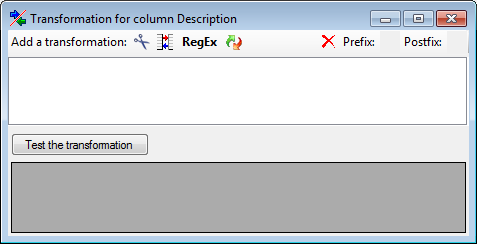
Here you can enter 6 types of transformation that should be applied to
your data.  Cut out parts,
Cut out parts,
 Translate contents from the file,
RegEx apply regular expressions or
Translate contents from the file,
RegEx apply regular expressions or  Replace text and apply Calculations
Σ or Filters
Replace text and apply Calculations
Σ or Filters
 on the data from the file. All transformations
will be applied in the sequence they had been entered. Finally, if a
prefix and/or a postfix are defined, these will be added after the
transformation. To remove a transformation, select it and click on the
on the data from the file. All transformations
will be applied in the sequence they had been entered. Finally, if a
prefix and/or a postfix are defined, these will be added after the
transformation. To remove a transformation, select it and click on the
 button.
button.
Cut
With the cut transformation  you can restrict the
data taken from the file to a part of the text in the file. This is done
by splitters and the position after splitting. In the example below, the
month of a date should be extracted from the information. To achieve
this, the splitter '.' is added and then the position set to 2. You
can change the direction of the sequence with the button
you can restrict the
data taken from the file to a part of the text in the file. This is done
by splitters and the position after splitting. In the example below, the
month of a date should be extracted from the information. To achieve
this, the splitter '.' is added and then the position set to 2. You
can change the direction of the sequence with the button
 Seq starting at the first position and
Seq starting at the first position and
 starting at the last position. Click on
the button Test the transformation to see the result of your
transformation.
starting at the last position. Click on
the button Test the transformation to see the result of your
transformation.
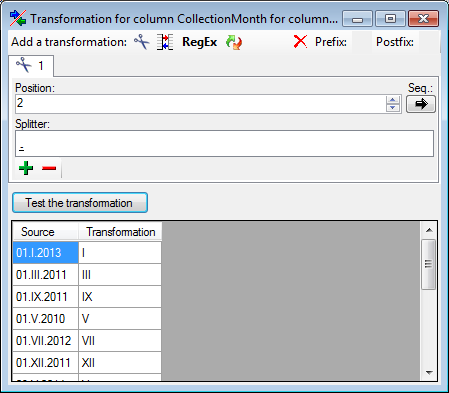
With the Start at Pos. option the given splitters will be converted
into space (' ') and the whole string starting with the given position
will be used (see below).

Translate
The translate transformation  translates
values from the file into values entered by the user. In the example
above, the values of the month should be translated from roman into
numeric notation. To do this click on the
translates
values from the file into values entered by the user. In the example
above, the values of the month should be translated from roman into
numeric notation. To do this click on the  button to add a translation transformation (see below). To list all
different values present in the data, click on the
button to add a translation transformation (see below). To list all
different values present in the data, click on the  button. A list as shown below will be created. You may as well use the
button. A list as shown below will be created. You may as well use the
 and
and  buttons to add or remove
values from the list or the
buttons to add or remove
values from the list or the  delete button to clear the
list. Then enter the translations as shown below. Use the
delete button to clear the
list. Then enter the translations as shown below. Use the
 save button to save entries and the Test the transformation button to see the result.
save button to save entries and the Test the transformation button to see the result.
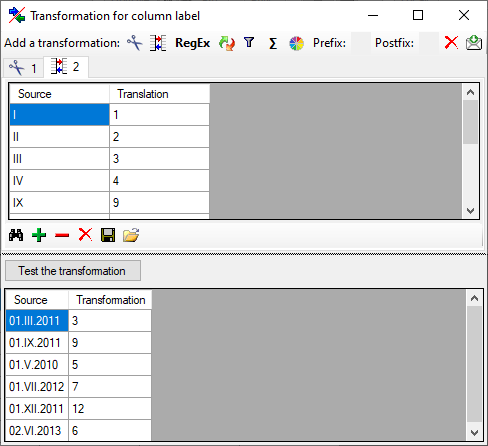
To load a predefined list for the transformation use the
 button. A window as shown below will open. Choose the Encoding of the data in your translation source and
indicate if the
button. A window as shown below will open. Choose the Encoding of the data in your translation source and
indicate if the  First line contains column definition. Click OK to use the values
from the file for the translation.
First line contains column definition. Click OK to use the values
from the file for the translation.
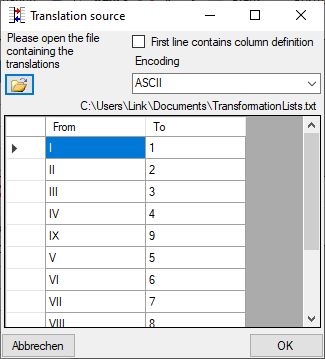
Regular expression
The transformation RegEx using regular expressions will transform the values
according to the entered Regular expression and Replace by
values. For more details please see documentations about regular
expressions.

Replacement
The replacement transformation  replaces any text in the data by a text
specified by the user. In the example shown below, the text "." is
replaced by "-".
replaces any text in the data by a text
specified by the user. In the example shown below, the text "." is
replaced by "-".
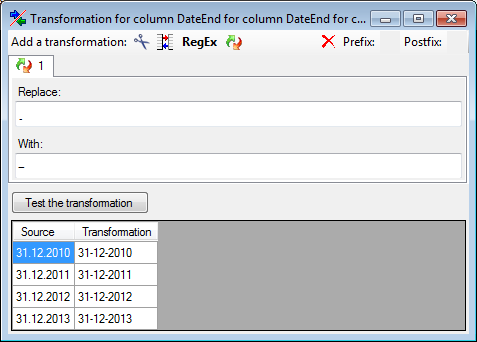
Calculation
The calculation transformation Σ performs a calculation on numeric value,
dependent on an optional condition. In the example below, 2 calculations
were applied to convert 2-digit values into 4 digit years.
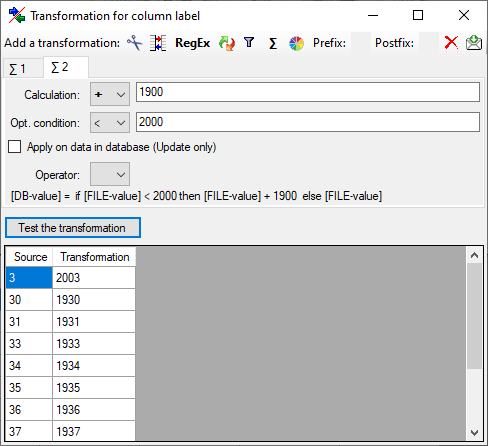
Filter
The filter transformation  compares the values from the data with a value
entered by the user. As a result you can either
compares the values from the data with a value
entered by the user. As a result you can either
 Export content into file or
Export content into file or
 Export fixed value. To select another
column that should be compared, click on the
Export fixed value. To select another
column that should be compared, click on the  button and choose a column from the file in the window that will open.
If the column that should be compared is not the column of the
transformation, the number of the column will be shown instead of the
button and choose a column from the file in the window that will open.
If the column that should be compared is not the column of the
transformation, the number of the column will be shown instead of the
 symbol. To add further filter conditions use
the
symbol. To add further filter conditions use
the  add button. For the combination of the conditions
you can choose among AND and OR.
add button. For the combination of the conditions
you can choose among AND and OR.

Diversity References
Export Wizard
Tutorial
This tutorial demonstrates the export of a small sample from the
database. For an introduction see a short tutorial
 .
.
Choosing the data
In the main form, select the data that should be exported (only the
data displayed in the query results are exported).
Exporting the data
Choose Data → Export →  Wizard →
Wizard →
 Organism ... from the menu. A window as shown
below will open where the available tables for export are listed in the
upper left area. To show the data columns of a table, select this table
in the list.
Organism ... from the menu. A window as shown
below will open where the available tables for export are listed in the
upper left area. To show the data columns of a table, select this table
in the list.

Adding additional tables
In this example, we want to add as many parallel identification tables
as present in the data. To do this, click on the
 button of the Identification table. At the end
of the list (depending on your data) the additional tables are added
(see below).
button of the Identification table. At the end
of the list (depending on your data) the additional tables are added
(see below).

Setting the sequence for the tables
To set the sequence of the Identifications, select the first table and
for the column IdentificationSequence set sorting sequence to 1 and the
direction for sorting to descending  .
.
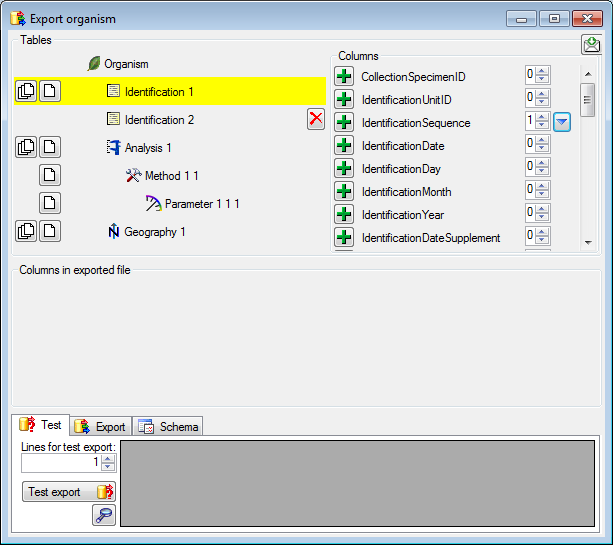
Choosing data from linked modules
Some columns provide the possibility to add data from linked tables or
modules. In this example we choose the column NameURI linking to the
module DiversityTaxonNames (see below).

To provide linked values, click on the  button.
A window as shown below will open, where you can choose among the
provided services.
button.
A window as shown below will open, where you can choose among the
provided services.
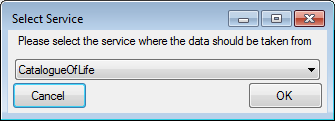
After the service is selected, you will be asked for the value provided
by the service (see below).
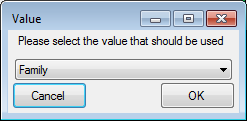
Now the selected link is added underneath the column as shown below. You
can add as many links as you need for your export.

For some modules there are values that refer to other modules with a
name like [Link to ...] as shown in the example below.

If you select one of theses values, you will be asked to select the
service or database linked to this modul (see below)

... and then to select one of the provided columns (see below)

Within the form this linked values will be marked as shown below. If
several results are retrieved these will be separated with by " | ".

Adding columns to the file
To add columns to the exported file, click on the  buttons for the columns resp. linked values. In this example select all
Family values and the TaxonomicName (see below).
buttons for the columns resp. linked values. In this example select all
Family values and the TaxonomicName (see below).

Fusing columns
The families should appear as one column and as the sources can exist
only once for each identification we can fuse these columns. To do so,
click on the delimiters  between these
columns (see below).
between these
columns (see below).

By default the headers for the exported data are set according to the
names of the columns in the database. To change this, edit them as shown
below where TaxonomicName has been changed to Taxon (see below). For
fused columns only the header in the first column will be used.

Testing
To test the export, click on the Test export
 button.
The result depends on the content in your data but should look similar
as shown below.
button.
The result depends on the content in your data but should look similar
as shown below.

Export
To finally export the data, choose the  Export tab. By default the data will be exported into tab separated
file in a directory in the application directory (see below). You can
change the directory (click on the
Export tab. By default the data will be exported into tab separated
file in a directory in the application directory (see below). You can
change the directory (click on the  button). You can choose the
button). You can choose the  Include
schema option to create a schema that you may reuse in a later export.
Include
schema option to create a schema that you may reuse in a later export.










 button to select a different target directory
before starting export.
button to select a different target directory
before starting export.

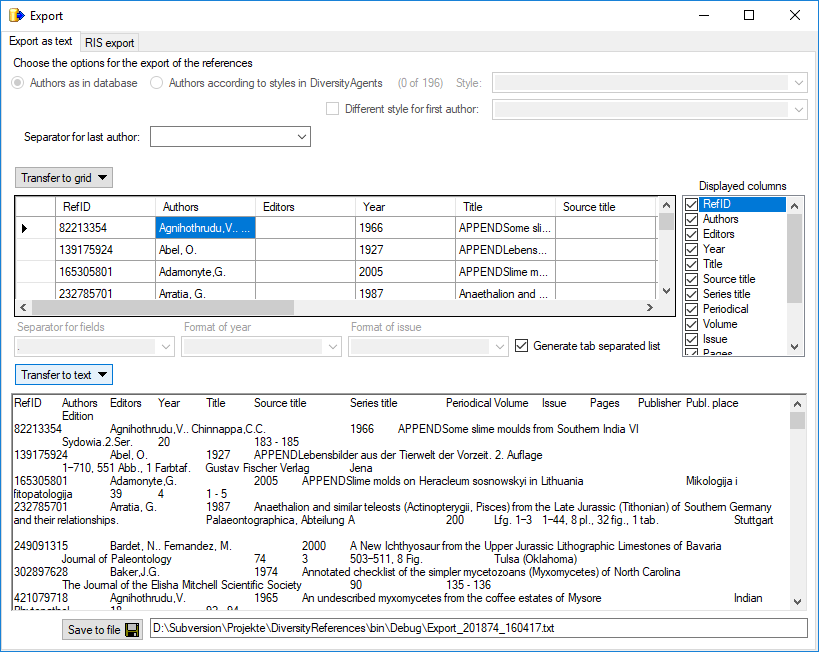
 The export wizard provides a possibility to export the data selected in
the main form. The data are exported as tab separated text file. The
export may include transformations of the data as well as information
provided by linked modules and webservices. Choose Data - Export -
Export wizard
The export wizard provides a possibility to export the data selected in
the main form. The data are exported as tab separated text file. The
export may include transformations of the data as well as information
provided by linked modules and webservices. Choose Data - Export -
Export wizard  There are the following ways to add tables:
There are the following ways to add tables: Several parallel tables according to
selected data
Several parallel tables according to
selected data Dependent table
Dependent table or
descending
or
descending  .
. or a module resp. webservice
or a module resp. webservice
 . Click on the
. Click on the  To add columns to the exported file, use the
To add columns to the exported file, use the  resp.
resp.  button. To fuse
a column with the previous column, click in the gray bar
button. To fuse
a column with the previous column, click in the gray bar
 on the left side of the column that will change to
on the left side of the column that will change to  for fused columns. To remove a file column, use the
for fused columns. To remove a file column, use the  delete button. Pre- and postfixes for the columns can directly be entered in the corresponding fields. To apply
delete button. Pre- and postfixes for the columns can directly be entered in the corresponding fields. To apply  button.
button.
 To filter the exported data, use the filter function. Click on the
To filter the exported data, use the filter function. Click on the
 This filter in contrast to the filter above strictly applies to the row
according to the sequence of the data. For an explanation see a short
tutorial
This filter in contrast to the filter above strictly applies to the row
according to the sequence of the data. For an explanation see a short
tutorial

 To test the export choose the
To test the export choose the  button.
button. include a schema option if you want to save a schema together with your
export. To start the export, click on the Export data
include a schema option if you want to save a schema together with your
export. To start the export, click on the Export data
 To export your data into a
To export your data into a  To handle the settings of your export, choose the
To handle the settings of your export, choose the
 undo button. To save the current
schema click on the
undo button. To save the current
schema click on the 
 Cut out parts,
Cut out parts,
 Translate contents from the file,
RegEx apply regular expressions or
Translate contents from the file,
RegEx apply regular expressions or  Replace text and apply Calculations
Σ or Filters
Replace text and apply Calculations
Σ or Filters
 Seq starting at the first position and
Seq starting at the first position and
 starting at the last position. Click on
the button Test the transformation to see the result of your
transformation.
starting at the last position. Click on
the button Test the transformation to see the result of your
transformation.

 button. A list as shown below will be created. You may as well use the
button. A list as shown below will be created. You may as well use the
 buttons to add or remove
values from the list or the
buttons to add or remove
values from the list or the 
 First line contains column definition. Click OK to use the values
from the file for the translation.
First line contains column definition. Click OK to use the values
from the file for the translation.



 Export content into file or
Export content into file or
 button and choose a column from the file in the window that will open.
If the column that should be compared is not the column of the
transformation, the number of the column will be shown instead of the
button and choose a column from the file in the window that will open.
If the column that should be compared is not the column of the
transformation, the number of the column will be shown instead of the

 Organism ... from the menu. A window as shown
below will open where the available tables for export are listed in the
upper left area. To show the data columns of a table, select this table
in the list.
Organism ... from the menu. A window as shown
below will open where the available tables for export are listed in the
upper left area. To show the data columns of a table, select this table
in the list.














